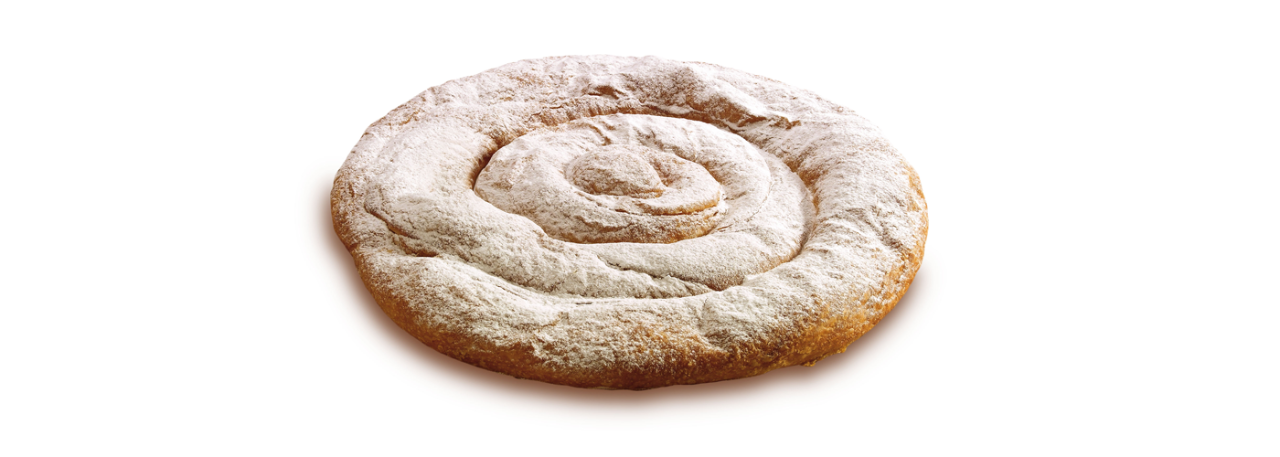.png.transform/rendition-xs/image_image%20(1).png)
Ensaimada de Mallorca PGI
A baked product made from sweetened, leavened dough. The ingredients are strong flour, water, sugar, eggs, mother dough (starter) and lard.
Tasting notes
A strong aroma of freshly-baked dough, the taste and smell of lard and a sweet flavor.
Other notes
A crisp, crumbly crust forming a spiral of two or more rings turning in a clockwise direction. The convexity between the turns can be seen when cut through. The surface of the different rings is irregular. The base is fatty, crisp, smooth and has no holes. It is golden but may be slightly darker or whitish if sprinkled with powdered sugar. The inside is soft, firm and inelastic, with visible air pockets. In the case of filled Ensaimadas, the threads of the pumpkin filling are distributed evenly in each of the rings. This is a handmade product that is baked daily and should be eaten within 3-4 days. After this period, it loses many of its characteristic organoleptic properties.
Ensaimada de Mallorca
- Weight: 60 g-2,000 g (2 oz-4 ½ lb)
- Moisture: From 10 to 20%
- Fat content: From 20 to 45%
- Filling: None
Ensaimada de Mallorca with crystallized pumpkin filling
- Weight: 100 g-3,000 g (3 ½ oz-6 ½ lb)
- Moisture: From 15 to 35%
- Fat content: From 15 to 40%
- Filling: Crystallized pumpkin.
Production / Processing method
Since this is a hand-made product it is difficult to give an exact formula. Certain intervals have been established defining the proportions for the different ingredients and giving rise to this top-quality, traditional product. The following ingredients are mixed in the proportions given:
- Strong flour, from 45 to 55 %
- Water, from 18 to 20 %
- Sugar, from 16 to 20 %
- Eggs, from 6 to 10 %
- Mother dough (starter), from 4 to 6 %
The mixture is worked to form a fine dough then completely covered with lard and rolled out until wafer thin. This is then rolled up into a long sausage shape and formed into a spiral having at least two rings. This spiral-shaped dough is then left to prove for at least 12 hours, and then baked.
In the case of filled Ensaimadas de Mallorca, the filling is added after rolling out the dough into a thin layer and before it is rolled up. There must be a minimum of 40 g (1 ½ oz) of crystallized pumpkin filling for every 100 g (3 ½ oz) of dough.
The Ensaimadas are sold whole, in octagonal or round cardboard packs, or are wrapped in suitable protective covering.
Geography / Relief and climate
Majorca lies at the center of the Balearic archipelago. With a surface area of 3,640 km2 (1,405 sq miles) and 448 km (278 miles) of coastline, it is the largest of the islands in the Autonomous Community of the Balearic Islands. It is made up of three main areas. The Sierra Norte or Tramontana, which rises sharply out of the sea and includes the archipelago’s highest peaks - Puig Mayor with 1,445 m (4,740 feet) and Masanella with 1,352 m (4,435 feet). The Pla is the broad, central depression where the main crops are grown. The Sierras de Levante lie to the east and south of the island, with lower peaks and gentler relief than the northern mountains. The Sierra Norte comprises three overlapping folds made of Jurassic and Cretaceous limestone that slid over Triassic marls, alongside levels of Miocene conglomerates, detrital limestone and marls. The Sierras de Levante had a similar geological formation with marl-type or marl-limestone materials from the Jurassic or Cretaceous.
The Pla comprises modern materials from the Miocene to the Quaternary, with strong formations of Quaternary marl, conglomerate, limestone and sandstone.
The climate is typically Mediterranean with moderate temperatures. Monthly averages are between 10ºC (50ºF) and 26ºC (78ºF), with slight fluctuations.
Rainfall is between 425 mm and 550 mm, with an average of 70 to 80 days of rain per year. Summers are periods of marked drought, which is partly made up for by high humidity levels.
The relative humidity is constant and high, with the exception of summer daytime fluctuations in which minima of 25% are reached. The annual average is 69%, with average monthly maxima in October and December, and minima in July.
The river system is made up of dry river beds and gorges in which water only flows after torrential rainfall. In the flat, low areas there are lagoons and wetlands, the most important being Alcudia, El Salobrar de Campos and Prat de Sant Jordi.
Regulatory Council
Consejo Regulador de la IGP Ensaimada de Mallorca
C/ Josep Darder Metge, 28 - Entlo.
07008 Palma de Mallorca
Tel: (+34) 971 276 145
pastissers@telefonica.net
www.illesbalearsqualitat.es
Sources:
- Spanish Ministry of Agriculture
It is golden but may be slightly darker or whitish if sprinkled with powdered sugar.


- Ensaimada de Mallorca 1
- Ensaimada de Mallorca 2

Palma de Mallorca (Balearic Islands)
